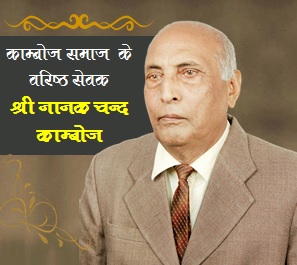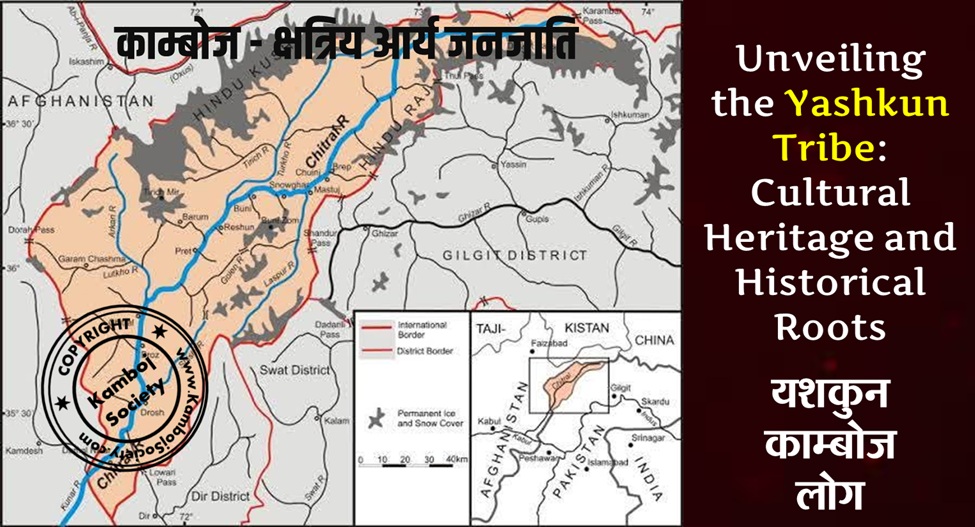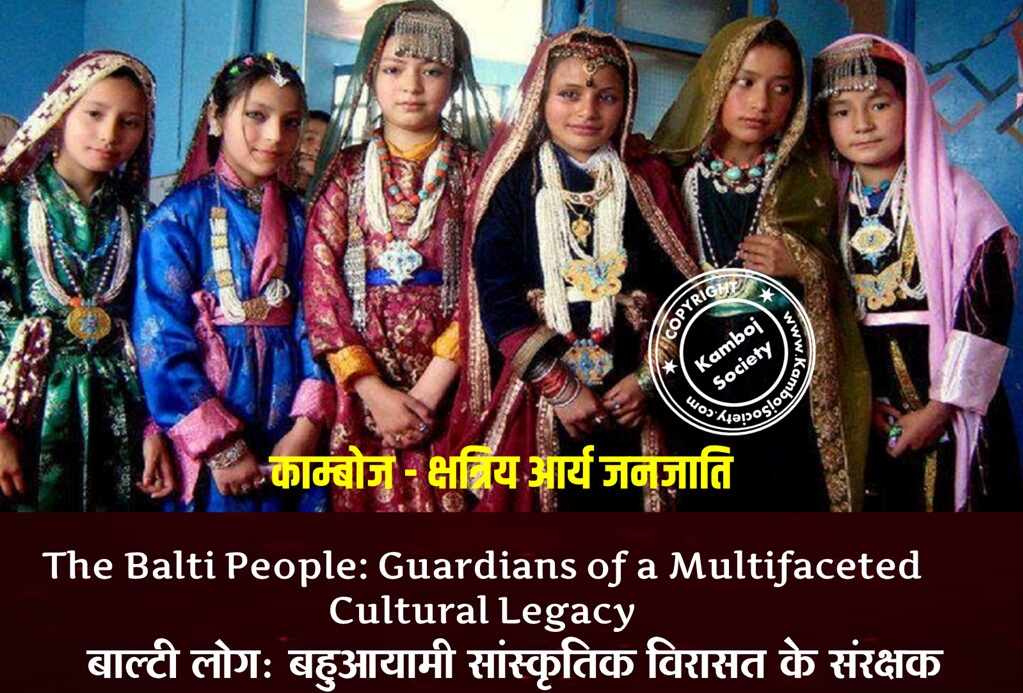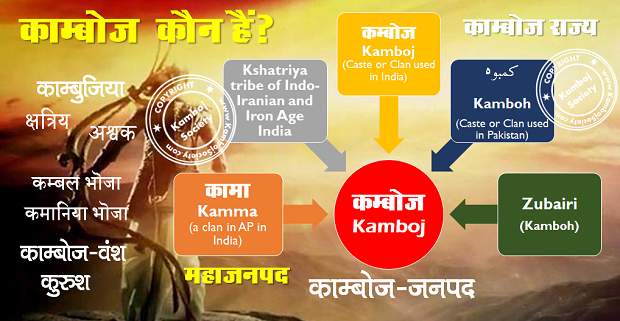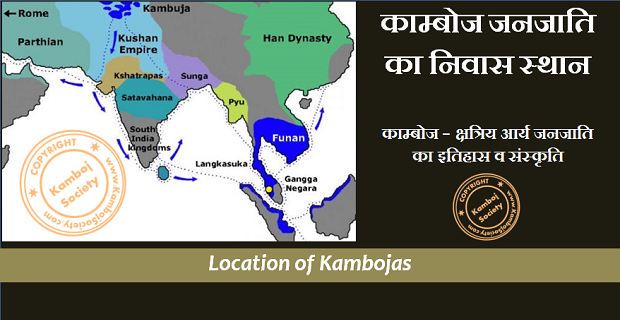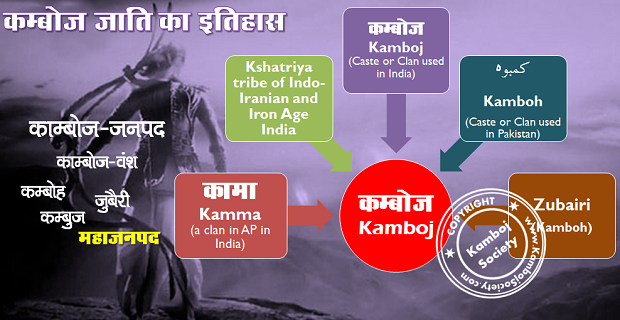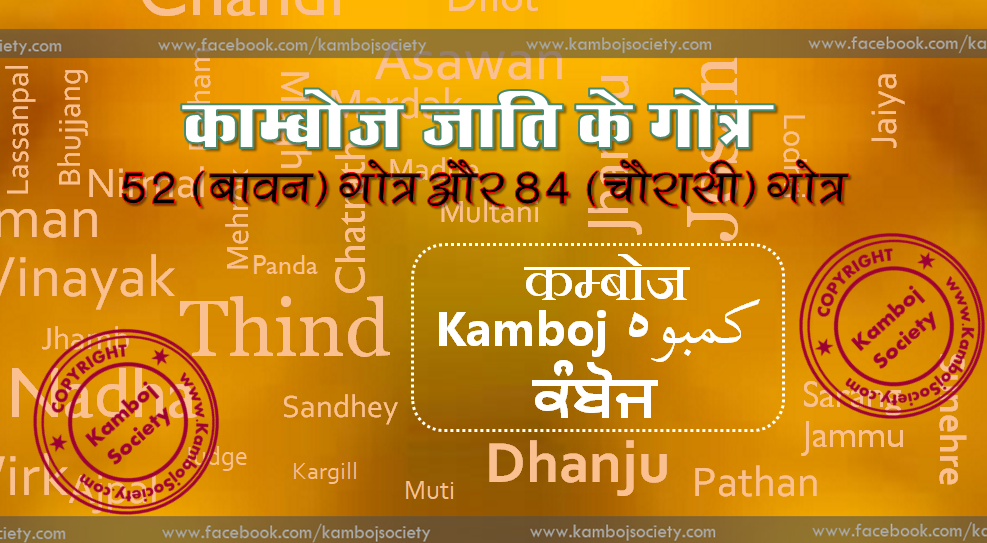Cambodia or Kambodia is the English transliteration of the French name Kambodge, which name stands for Sanskrit Kamboja (Persian Kambujiya or Kambaujiya). In Chinese historical accounts, the land was known as Chenla. The ancient inscriptions of Cambodia always refer to this name as Kambuja or Kamvuja rather than the standard Kamboja. Kamboja was the name of the Indo-Iranian tribe and their country originally located in Pamirs and Badakshan in Central Asia but later some clans of this people had moved south and transplanted colonies in eastern and Central Afghanistan also. During early second century BCE, some clans of this people in alliance with the Sakas, Pahlavas, and Yavanas had entered India and spread into Sindhu, Sauvira, Punjab, Rajasthan and Saurashtra/Gujarat from where they spread further into Central, Eastern and Southern India. It is believed that a group from amongst these south-western Kambojas (i.e. Gujarat/Saurashtra) had sailed to Southeast Asia and founded the Kambuja colony in Mekong valley of Indo-China Archipelago.
1 Political vs Cultural Connections
It was first pointed by Dr D. B. Spooner that there is a connection between the very name Kambodia and the Persian borderland Kamboja[2]. It has been held by some that the Vedic name Kamboja from north-west had got transplanted into Indo-China by the process of Aryanisation or Sanskritisation, where the sacred geography of Sanskrit classics was replicated and the old Sanskrit names with their hallowed topography were faithfully adopted by far-flung rulers in their anxiety to garner prestige [3]. But, it is added here that while this may be true for names like Ayodhya, Mathura, Kusumpura, Vaishali, Indrapuri, Hastinapura, Dvaravati etc which names may have been adopted in the south-east because of their hallowed topography as they all belonged to the sacred geography of Aryavarta, but the names like Kamboja, Gandhara, Takshsila , Rajapura, Singanagari (Sinhapura of Salt Range?), Rumadesa (Rumaveise) etc which were considered a part of the Bahikadesa (outlier country) and therefore, the land of the despised Mlechcha or Barbaric people, were not reputed around this time for their sacred or hallowed geography. The reference to these names in the Javan and Kambodian legends clearly implies that there was a direct historical and political rather than cultural connection with the Far East [4] Bombay Gazetteer also writes: "Fair ground can therefore be claimed for the presumption that the leading position given to Kamboja, Gandhara, Taxila and Rumadesha in Javan and Kambodian legends and place-names is a trace of an actual and direct historical and political connection between the north-west of India and the Malay Archepelago" [5]. Ancient inscriptional and literary evidence quite supports the above view. Modern research reveals that there had been direct historical and political relations between the Indo-Iranian Kambojas and the regions/countries like southern India, Sri Lanka, Burma, Suvaranabhumi (Malay Peninsula) and the Kambuja of Indo-China Archipelago. The historical connections between Kambodia and the Indo-Iranian Kambojas appear to go back to first few centuries of Christian era. This relates to the time-frame when the Kambojas from Central Asia had out-spread into south-west and southern India in alliance with the Sakas, Pahlavas and the Yavanas etc. Initially, the intercourse between the Kambojas and Indochinese Kambuja was purely commercial but with time it had evolved into political and colonial relationship. In ancient inscriptions of Kambuja, the Kambuja rulers expressly state themselves from the lineage of the Kambujas. The Baksei Chamkrong inscriptions dated 947 AD tries to link the lineage of Kambuja ruling family to a legendary prince Kambu and Aphsara Mera [6]. This mythical connection was apparently designed by over-flattering court purohits of the Cambodian ruling family to give a divine and noble origin to the Kambuja rulers which should accord with their royal splendour and worldly glory. Probably, the conditions of time had necessitated this device since the Kambojas at this time had come to be regarded as of the Mlechcha and Barbaric status in the eyes of orthox Brahmanical class. Thus, instead of directly admitting that king Rajendravarman II was of the Kamboja lineage, the Baksei Chamkrong inscriptions instead follows a round-about way to attribute to him a divine lineage from sage-prince Svayambhuva Kambu ( i.e. Kambuja=Kamboja) and Apsara (celestial nymph) Mera[7]. The modern scholars do not believe the Kambu-Mera legend on the origin of the Kambuja rulers of Cambodia [8] [9] [10].2 Evidence of Commercial Connections
Ancient Buddhist texts like Ankuravathu section of Petavatthu Jataka attests that a direct caravan route (known as Kamboja-Dvaravat marga) existed between ancient Kamboja (Pamir- Badakshan) and port of Dvaravati in Saurashtra peninsula [11] In ancient times, Saurashtra had been a great center of trade where merchants from various nations used to flock [12] Ancient Sanskrit texts like Kautiliya Arthashastra, Brhatsamhita, Mahabharata and Ramayana etc attest that, besides being formidable warriors (Shastr-opajivins), the ancient Kambojas were also noted as excellent traders , agriculturists and cattle-culturists (varta-opajivins).[13] The Periplus of the Erythraean Sea makes mention of several sea ports beginning with Barbaricum at the mouth of the Indus, followed by Barygaza (Bharukachcha, modern Bharoch), Soparaka (Sopara), Calliena (Kalyan) and Muziris (in Kerala) etc all located along the west coast of India southwards. Besides these more important sea-ports, there were also lesser ports like Sindan, Dvaravati, Kamboika (Kambojika, on gulf of Khambat) and Gandhar (near Bharukachcha) etc. The important international ports of Barbaricum, Bharukachcha, Dvaravati, and Soparaka were easily accessible for international trade and the merchants from Kamboja, Gandhara, Sindhu, Sauvira, and Saurashtra used to sail from these ports on the country's western coast. Huge trade ships carrying merchandise from Kamboja, Gandhara, Sindhu, Saurashtra etc in western India are said to have been sailing from there directly to southern India, Sri Lanka, south Myanmar and Suvarnabhumi. The ports of Gandhara and Kamboika located in south-east Saurashtra probably also served as residential headquarters for the traders from Gandhara and Kamboja. It is also significant that early Buddhist literary sources from north India refer to the northerners as being involved in trade in horses [14]. Evidence exists that horse merchants from Kamboja were in active trade as far as Ceylone. This trade had been going on with eastern, western and southern India as late as medieval ages. King Devapala (810-850 CE) of Bengal, king Vishnuvardhana of Hoysala dynasty (1106 - 1152 CE) of Mysore and king Vallabhadeva of Pandya kingdom (12th century CE) located in extreme southern tip of India, had powerful fleets of Kamboja horses in their cavalry. Dr Don Martino observes: The traders from north-west Kamboja had been conducting trade in horses with Sri Lanka following west coast of India since remote antiquity [15]. According to Dr E. Muller also, "… (with time) the Kambojas had adopted the Mussalman creed and used to trade all along the west coast of India from Persian Gulf down to Ceylone and probably further-east…" [16] See also: Kamboja-Dvaravati Route.2.1 Kamboja & Yavana Colonies in Sri Lanka
There are a number of indications that the Indian expansion in the first few centuies AD was commercial in origin. [17] Sinhalese inscriptions from Koravakgala at Situlpahuwa in the Hambantota district contain the word "Kaboja"' (Sanskrit Kamboja) and attest the existence of one Grand Trade Guild of the Kambojas ( Kabojhya Mahapugyana)[18] and one Kamboja Sangha (Gote-Kabojhyana) [19] in Anuradhapura in ancient Sinhala. This evidence incontrovertibly proves that the Kambojas were actively involved in the international trade by sea with Ceylon and other nations beyond [20]. Scholars believe that these inscriptions date back to at least third or second century BCE or earlier. There is also a reference to one Kamboja-gama i.e a village named Kamboja in the Rohana province of Anuradhapura. The Pali text Sihalavatthu of about fourth century CE, attests that a group of people called the Kambojas (p 109) were in Rohana on the Island of Tambapanni i.e Sri Lanka [21] [22] [23]. Similarly, the Yona colonists are also attested to have been settled in Pandukabhaya in Anuradhapura [24] [25] [26] who were also probably a group of traders from the north-west. Several Iranian records speak of an embassy from Sri Lankan king to Iranian emperor Anusharwan (Ruled 531 AD-578 AD). Sri Lankan king is reported to have sent the Persian emperor ten elephants, two hundred thousand pierces of teakwood and seven pearl divers.2.2 Kamboja Merchants in Indo-China Peninsula
| This article is part of the History of Cambodia series |
|---|
| Early history of Cambodia |
| Migration of Kambojas |
| Funan (1CE - 630CE) |
| Chenla (630CE - 802CE) |
| Khmer Empire (802CE - 1432CE) |
| Cambodia (1432 - 1864) |
| Dark ages of Cambodia (1432 - 1887) |
| Colonial Cambodia |
| Cambodia under Sihanouk (1954-1970) |
| Cambodian Civil War |
| Democratic Kampuchea |
| History of Cambodia (1979-present) |
3 The Trail is Clearly Visible
The foregoing discussion demonstrates that from the Kamboja located in north-east Afghanistan, the Kamboj merchants travelled to Gujarat/Saurashtra following either the well known Kamboja-Dvaravati land route or the water-course of river Indus . The landlocked port of Kamboi (Kamboika < Kambojika) and the Gulf of Kambey (Khambat or Kambat) in Saurashtra carry the unmistakeable relics of the Kamboj presence in Gujarat [42]. From Gujarat following sea-route, the Kambojas sailed to Sri Lanka . The presence of 'Grand Trade Guild of Kambojas' (Kabojhiya-mahapugiyana) as well as one 'Kamboja Sangha or Corporation' (Gota-Kabojhi(ya]na) in ancient Anuradhapura province and one Kambojagama (Kamboja village) in Rohana province in Sri Lanka verify ancient Kamboj trade-activities in that island. From Sri Lanka, the Kamboj traders/colonists took sea-route in Indian Ocean and reached Ligor (Central Malaya) which also seems to have formed another Kamboja commercial stronghold in Malay Peninsula. From Malay Peninsula following the Takola-Mart land route, they reached central Thailand. The ancient Kambojagama located in the south-east of Haripunjaya in lower Menam verifies Kamboja settlement in Thailand as well. On further movement, the Kamboj colonists apparently reached Bassac near Vat-Ph'u hill in Mekong valley where they founded the well-known Kambuja or Kamboja colony of Indo-China. The above trail seems to be quite logical and scientific and probably leaves no room for suspicion or skepticism.4 From Commercial to Political Arena
With time, the Kamboja trade settlement in the land of abundance i.e Mekong basin grew in importance. and assumed wider political dimensions. Possibly, the Kamboja trading community was soon followed by some adventurous Kamboja Chieftain (probably the Kambu of the Cambodian legends) accompanied by a band of soldiers who gave political twist to the story and converted the commercial settlement into organised political State to be known as Kambuja kingdom. Some scholars like John Keay express doubts as to how could the Kambojas located in the extreme north-west of Indian subcontinent be related to the Kambuja rulers of Indo-China when the two were separated by a distance more than 3000 thousands mile apart! [43]. The answer to John's question is very simple as follows:- The merchants from Kamboja were already settled in ancient Sri Lanka prior to Christian era as is powerfully attested by numerous ancient epigraphic inscriptions of Sri Lanka. The distance, therefore, was never 3000 miles but much less and easy to traverse. Moreover, the incidence is not unique in history. We have somewhat similar analogy though separated in time by more than thousand years, in respect of the European traders who also came to India and Far-East as traders but later grew in power and became masters of the Indian subcontinent and of Cambodia. If the traders from European countries, located thousands of miles away could do it in India and Far East in seventeenth century AD, then the Kamboja traders from Saurashtra /Gujarat or better still from Sri Lanka could also have done it easily in the nearby Indo-China in 5th/6th centuries as well.5 Legends About Kambuja
There are several myths on the origin of Kambuja kingdom in Southeast Asia. Scholars like Casey suppose that Kambuja lineage of the ruling family of ancient Cambodia had originated from the legendary patriarch figure called Svayambhuva Kambu of the Kambu-Mera legend who is stated to have been a prince from Arya-desa. Casey also states that "Kambuja" is etymologically related to the name "Kambu" as Kambu+ja, where "ja" in Sanskrit is said to mean "son or descendant". Hence, Kambujas according to Casey's interprettation meant "descendants of prince Kambu". Commenting on the Kambu-Mera legend, Dr J. L.Kamboj writes that the Kambu legend seems to imply that some learned and adventurous chieftain from Kamboj lineage managed to reach Mekong basin and laid the foundations of Kambuja in Indo-China. According to Dr Kamboj, name Kambu and Kambuj are apparently corrupted forms of the standard Sanskrit term Kamboj [44] Another popular legend prevalent in Kambuja says that there once ruled a great and wise prince in Romaveise (Rumadesa). Annoyed with his son Phra-Thing on some counts, the king sent him into exile. After numerous hardships, the young prince established himself in what is called Kambuja and gave it the current name [45]. It is worth remembering that the Rumadesa or Rumaviese was the ancient name of salt-range area located to the north-west Punjab [46]. Thus, Romaveise or Rumadesa country was very contiguous to the ancient Kamboja which fact certainly implies that the young prince referred to in this Cambodian legend may have been the learned prince Kambu (Kamboj) of the Kambu-Mera legend. The earliest known members of the Kamboja royal family in Kambuja from the lineage of sage-prince Kambu are prince Srutavarman (little son of prince Kambu), prince Shreshthavarman, prince Viravarman and princess Kambuja-rajalakshami.6 Vasishtha, Agasti, Kaundinya and Kambhoja Connection
Sage Vasishtha and Agasti were brothers and sons of Mitravaruna (Mithravaruna). Sage Vasishtha had several sons including Shakti, Indra Pramati, Kundina etc. From Vasishtha began the Vasishtha clan of the Brahmanas, from Kundina, the Kaundinya line and from Agasti the Agastya line of Brahmanas. There are several references in ancient Sanskrit literature which indicate close connections between the Vasishthas and ancient Kambojas [47]. Sage Vasishtha and his descendants were mostly active in the Aryanisation of north and north-western India. But sage Agasti, sage Kundina and their descendants played active role in the Sanskritization of southern India. One sage Kaundinya finds reference in Satapatha Brahamana (14-155,20) as well as in Mahabharata. There are numerous references to the Kaundinyas in Indian inscriptions and Tamil literature. Southern Indian recension of Ramayana refers to one Kambhoja sage who was close friend of sage Agasti and had his hermitage on the banks of river Godavari (See Abduction of Sita: Panchavati). This epic reference, if to be believed, indicates that the seers from the Agastya, Kambhoja and Kaundiniya lines were all involved in the Aryanisation of southern India. It appears likely that after these seers and missionaries had completed the Aryanisation of southern India, they had transplanted themselves to Southeast Asia including Suvaranabhumi and Indo-China in order to expand the boundaries of Aryan India. [48]. Thus, we find respective references to sage Kaundiniya as well as to prince Kambu or Kambuja (i.e. Kamboja), the founders of kingdom of Funan as well as of Kambuja as referenced in the ancient Kambodian legends. For Kamboja-Vasishtha connections, see also: Brahmanism of Ancient Kambojas7 Suryavamshi (Solar) vs Chandravamshi (Lunar) kings
Funan line of kings is said to have belonged to the lunar (Chandravamsa) lineage of Kshatriyas . Likewise, the Kambuja line of kings is stated to have belonged to the solar (Suryavamsa) lineage [49] . This proves that so-called sage Kaundinya as well as the learned prince Svayabhumva Kambu (or Kambuja) were both from the Kshatriya lineage since SOLAR and LUNAR lineages are attributed to the Kshatriyas only. Therefore, it appears likely that Kaundinya, the so-called founder of Funan colony in Indo-China was probably a Kshatriya chief who became known as Kaundinya possibly because of the fact that his familiy priests belonged to Kaundinya gotra Brahmins. Further, the family name of the kings of Kambuja is stated to have been Cha'li which means Kshatriya.[50]. [51][52] If this evidence is to be believed, then we may have to accept that the the founder-colonists of Funan and Kambuja dynasties were from Kshatriya lineage and were probably the Kambojas from Gujarat/Saurashtra.8 Alternative Views on Routes of Immigration
We have stressed here that the Kamboja colonists of Kambuja in Indo-China were from Saurashtra/Gujarat who had their trade-posts already operative in Anuradhapura in Sri Lanka. To all probability, it was a Kamboja section from Gujarat (or better from Sri Lanka) who had sailed to Far East as traders/merchants and colonised Kambuja in Indochina around centuries of AD. But alternatives views have also been suggested. According to Dr. P. C. Bagchi, the Kambojas who had set-up the Kambuja colony in Indo-China were a nomadic tribe of Central Asia and had reached Mekong basin via Tibet, following the land route behind the Himalayans [53]. It is interesting to note that Brahmanical Sanskrit text Brahama Purana, believed to be a creation of 5th century AD, attests one section of the Kambojas to have been living near Tibet/ Assam. The province Khamba of Tibet still carries the relics of Sankrit Kamboja [54]. Probably, they were a section of the Kashmiri/Pamiran Kambojas who may have receded to Tibet in the wake of Kushan pressure during first or second century AD. Noted scholar Sir James Fergusson has also listed one of the possibilities that the Kambojas might have followed the land route behind the Himalayan to reach Indochina [55] Celibrated George Coedes also states that the penetrations of the colonists to Southeast Asia may have been through the narrow valleys of rivers originating in China and the confines of Tibet [56]. Chiang Kien, a Chinese Envoy to Bactria (127 BCE) leaves us evidence of the Bamboos and textiles being imported from South-west China and sold in the local markets of Afghanistan. On his enquiry, he learnt that these goods were first brought to East India through Yunnan, Burma-Tamralipti from where they came all the way to North India-Afghanistan following apparently the famed Uttarapatha land route [57] . All these references sufficiently indicate the existence of alternative land routes by which the colonists including the Kambojas might have landed into Indo-China.9 Opinions of Some Scholars
- Dr B. R. Chatterjee:
- The descendants of the Kambojas are the modern Kambohs. Among 84 clans (gotras), the names of which are said to have been derived from the name of Siva, figure figure people of Maga reminding us of the Iranian Magi, and Kamari or Khamari, providing us with a probable explainationof the name Khmer, the people of Kamboja desa par excellence [58]
- Dr P. C. Bagchi:
- Kambojas were a nomadic tribe of Central Asia. It appears that one of their branch had crossed Hindukush and had entered India. They have assimiliated into local Indian popualtion to such extent that it is impossible now to identify them from the rest of the population. Other of their section appears to have entered east Tibet and further Mekong valley (Cambodia). This assumption can straight away explain as to why Mekong basin of Indo-China was known as Kambuja. We can also find the trace of their name in the Khamba province of east Tibet. Probably the Kambojas who had invaded Assam and Bengal in the later centuries had come from the Khamba province of Tibet [59].
- Bombay Gazetteer:
- The Indian colonists from north-west India (i.e. Kamboja, Gandhara, Romadeisha, Taxila) had reached Kambodia via Sea Ships launched from Suarashtra/Gujarat sea coasts of western India. Numerous legends and traditons with regard to Java and Kambodia are still prevalent in Gujarat/Kathhiawad regions which show that Gujarat sea-coasts had been the launching pads for these sea-adventures to the Far East. These legends further shed light on trade relations between Java/Kambuja and the north-west India during first few centuries of Christian era . [60].
- Dr R. K. Mukerjee:
- Dr R. K. Mukerjee, a distinguished Indian historian and scholar: The far-famed ancient regions of India such as Gandhara, Kamboja, Kalinga, Dasarana, Malava, Sriksetra and Ayudhya etc had transplanted themselves across the seas into Indo-China[61]
- Sir James Fergusson:
- According to Sir James Fergussan, 'there is a marked similarity in the art and architecture of Kambuja and of north west Indian regions like Kabul, Kashmir and Taxila [i.e. land of Kambojas]. There is also a marked similarity between the Wood-Carving Art of Kambuja and of north-west regions of India. Furthermore, Kambuja and north-west regions have a marked similarity in matters of religious beliefs as well as customs like Snake worship. There has always been special stress on snake worship in the north-west division and it is a common knowledge that Uttarapatha which included Kabul, Taxila and Kashmira had been the home of snake worship since ancient times. This practice of snake worship in Kambuja was taken from ancient Kamboja janapada and nearby Kashmir of North-west India......If it is true that the Kambujas of Indochina came from India, then to all probability, they had come from Kamboja located in the north-west rather than from the east coast of India as some scholars tend to believe'. [62] [63]. Other scholars also see close connections between the sculpture, architecture and religious beliefs of the people of Kashmir, Kabol, Gandhar and Punjab and those of the Kambuja. The artistic exquisiteness, flawless craftsmanship, ingenious workmanship, delicacy, finesse, elaborate execution & perfection and esoteric appeal seen in the architecture of Kamboja is chiefly borrowed from north-west India. The art and craft, architecture, sculpture, wood-carving and metal-work of Gandhara and Kaofu/Kaofend/Kipin (Kamboj, Kabol valley) has also been praised in the accounts belonging to the Han (206BC-24 AD) and Wei (386 AD-556 AD) dynasties of China. [64][65][66].
- Goerge Coedes:
- Writes G. Coedes: "Perhaps the reign of this foreigner (i.e Indian prince Chan-ta'n who seized the throne of Funan in 357), coming after the exchange of embassy with Murundas (Kushanas), accounts for some connections we are tempted to establish in several fields between Funan and ancient Cambodia on the one hand and the Iranian world on the other. We will see later that at the end of fifth century, the servant of a king of Funan bore the name or title of Chiu-ch'ou-lo, which could be identical with title Kujula in use among the Kushans. A little later, in seventh century, we see a Scythian (Saka) Brahman arriving from Dekkan and marrying the daughter of king Ishanvarman I. The pre-Angkorian iconography of images of Surya, with their short tunics, short boots and sashes similar to those of Zoroastrians, is clearly of Iranian inspiration. Perhaps these images represent the sun considered as a Magian or Scythian Brahman., who is designated by the name Sakabrahmana in Angkorian epigraphy. Even the cylindrical coiffure of the pre-Angkorian images of Vishnu can be regarded as showing Iranian influence. It is true that the immediatev model for this hair style is found in the sculpture of the Pallavas of Kanchi, but we also know that one group of scholars is convinced of the northern origin of the Pallavas, maintaining that they are descendants of the Pahlavas. Finally, even the name of the Kambujas, the heirs of Funan, may be related to the Iranian Kambojas. It would be imprudent for the moment to push these comparisons too far, but the discovery at Oc Eo in western Cochin China of an intaglio representing libation to fire and of a cabochon with a Sassanid effigy has furnished tangible proof if Funan's relations with Iranian world" . [67].
- Dr Buddha Parkash:
- A Kushan prince Chan-ta-n, who had transplanted himself into Indo-China is said to have seized the throne from the ruling dynasty of Funan. Following this, the Shakas and some other related people also entered Indo-China. It is reasonable to believe that the Kambojas had joined this move and set up a Kambuja colony in the north of Funan kingdom. [68] "The author of the Vayu Purana uses Kushadvipa for Kumudadvipa. This Kumuda is the Komdei of Ptolemy and represents an Iranian tribe living in the frontiers of ancient India, especially in the Badakshan region. In the succeeding centuries, a section of these people had settled on the Indian plains. It is believable that at the start of Christian era, a section of this people had also moved to South-East Asia and settled in what later came to be known as Kambuja. They went to other places as well". [69]
- Dr J. L. Kamboj:
- "The ancient Kambojas are known to have been living in Pamir- Badakshan. With time, section of them crossed Hindukush and settled not only in Kabol, Gandhar and Kashmir but during second/first centuries BCE, in alliance with Shakas, Yavanas and Parthavas they had spread into Sindhu Sauvira, Gujarat-Kathiwad, Rajasthan, Punjab as well as eastern and southern parts of India as well. A group from these Kambojas had later went to South-East Asia and set-up a Kambuja colony in Mekong basin in Indo-China…..……..The Kambojas who founded the Kambuja colony in Mekong basin came from north-west Kamboja following the land route through Siam and Laos" . [70]
- Chaudhury Bawauddin:
- Until fifth century AD, the Parthians, Shakas and the Kambojas had been ruling in northern/north-western parts of India. The Kamboja kingdom of the north-west became a first target to the Hunas in 470 AD in which the Kambojas appear to have lost the battle. These were indeed difficult times for the Kambojas since little later they had also lost Kathiawad- Gujarat to the invaders. As a consequence, a section of the Kambojas had left India either via Bengal and Burma,following a land route via Siam and Laos to Indo-China or else after the destruction of Vallabhi in Saurashtra, they left Gujarat, sailed along west coast of India following sea route via Sri Lanka, reached Indo-China and founded the Kambuja kingdom there. [71]
- Journalist Rama Rao:
- "Kambhojas are anciently mentioned to live in the region of Punjab and there is an echo of a migration to somewhere on the Godavari. Later from there seafarers and adventurers gave the name to a region of southeast asia --Kampuchea or Cambodia. "'
- Prof Sudarshan Tiwari
- Commenting on verses (X.43-44) of Manusmriti[72], Prof Tiwari writes as under: "Shakas were white skinned tribes according to legend on contests between Vasishtha and Viswamitra of the epics. According to Manusmriti (X.43-44), they, along with Paundrakas, Odras (who are called Andhras in Indian history), Dravidas, Kambojas (the Vermas who later ruled Cambodia), Yavanas, Paradas, Pahlavas (the Verma Kings of later Mamallapuram), Chinas (Chin rulers of China ?), Kiratas (rulers of Nepal mountains), Daradas, and Khasas as 'Varatya Kshatriyas' (Kalluka's comments) …… "
10 Few Hints on India's Commercial Intercourse with Far-East
- There are numerous references in Indian texts, accounts of Arab travelers, Chinese historical accounts, old inscriptions as well as the magnificent ruins of ancient monuments like Angkor and Borobudur which demonstrate India's ancient connections with the Far East. The old stories in Sanskrit contain many accounts of perilous sea voyages and ship-wrecks. Non-Indian accounts like those from the Greeks and Arabs show that there was a regular maritime intercourse between India and the Far East, at least, as early as first century BC.[73]Ancient books like Kathasagara, Buddhist Jatakas etc refer to the fascinating regions of the Far East including Suvarnabhumi, the fabulous "Land of Gold." [74]. Evidence shows that wave after wave of traders, colonists, priests and craftsmen reached southern Asia, Ceylon, Siam and distant Cambodia both from east and west coasts of India. A prince from Gujarat is said to have embarked with 5000 followers in 6 large and about 100 small vessels and settled at Matarem in the center of the Java in 603 AD. Extensive trade and commerce was carried on with Gujarat and other countries, and the bay of Matarem was filled with adventurers from all parts [75]. The Indian colonists brought Indian art and architecture into Far East where the Indian sculpture achieved its greatest triumphs " [76]. Passenger ships plied regularly between the Gujarat, Ceylon, Ganges and Malay Peninsula (Suvarabhumi) in the middle of the first millennium A.D[77]. "There is a confirmation of the account we have of the large ships from the time of Agatharcides down to the 16th century, the ships of Gujarat which traversed the Indian ocean in all ages." (Dr V. A. Smith)
- According to Pandit Nehru: "From the first century of the Christian era onward wave after wave of Indian colonists spread east and south-east reaching Ceylon, Burma, Malaya, Java, Sumatra, Borneo, Siam , Cambodia, and Indo-China. ………. There appear to have been four principal waves of colonization from the first century A.C. and in between there must have been a stream of people going eastwards. But the most remarkable feature of these ventures was that they were evidently organized by the state….. The Cambodia, as it is known now, was called Kamboja, which was a well known town in ancient India, in Gandhara or the Kabul Valley. This itself indicates roughly the period of this colonization, for at that time Gandhara (Afghanistan) must have been an important part of Aryan India".[78].
- Cultural Heritage of Ancient India observes: "The impact of Indian trade and culture in the neighboring countries is traced as early as third century B.C. if not earlier. Indians migrated in large numbers to Malaysia and Indonesia in ancient times. We find place-names in Sanskrit in Sumatra, Java, Champa, Kambuja, Suvarnabhumi and Suvarnadvipa bearing unmistakable evidences of the early cultural and commercial, if not political, colonisation of the Western Pacific by the Indians. The earliest inscriptions so far traced in Champa ( Vietnam), Java and Borneo were inscribed in the Brahmi script of north Indian variety and in Sanskrit language........Indian merchants, princes, priests, monks, and intellectuals both Brahmanical and Buddhist cooperated intensively with the gifted indigenous populations. Thus the foundation was laid of the Greater Indian Concept which was predominantly a cultural expression of the collaboration of the races and nations….." [79]
- Prof Ratanlal Joshi writes: "Kashmir has not only been the source for the development of Sanskrit literature but the stories of Mahabharata, Ramayana and Buddha spread throughout Asia, China, and Japan from this region only. It was from Kashmir that Indian culture along with Sanskrit literature and Buddhism traveled to various countries of Asia and merged with their cultures. Even today, this is visible in the cultures of Indonesia, Philippines, Malaya, Kamboj (Cambodia) and Siam. Kashmir has acted as a launch-medium to spread the Indian culture all over Asia. It was a medium and a central point from which Indian culture spread from Sri Lanka to Central Asia and from Egypt to Japan.... The China and Kambodia are also known to have been receiving their consignments of Saffron from Kashmir.....". Further, according to the same author, the Kambojas had also ruled over Kashmir. Mahabharata (VII.4.5) also informs us that the Kambojas had ruled over Kashmir [80]. Thus, the above text from Prof Joshi also implies that cultural and commercial intercourse existed between Kashmir/Kamboja of north-west the Kambuja/Cambodia of Southeast Asia. [81]
11 Prince Norodam Sihanouk and Indian Kambojas
12 References
- E.g: Shri Kambujendrasantankamhiruha---Inscriptions du Cambodge Vol I, p 149, G. Coedes
- May I not also note that the very name Kambodia seems reminiscent of the Persian border-land Kamboja?–Journal of Royal Asiatic Society, 1915, p 447
- See: India: A History, 2001, p 176, Grove Press, John Keay
- Ancient Kamboja, People and the Country, 1981, p 358, Dr J. L. Kamboj.
- Bombay Gazetteer Vol I, Part I, p 491).
- Inscriptions du Cambodge, Vol I, p 149, G Coedes; Indianised States of Southeast Asia, 1968, p 66, George Coedes
- cf: Goerge Coedes, Inscriptions du Cambodge, II, pp. 10, 155
- Aryan and non-Aryan Names in Vedic India, Data for the linguistic situation, c. 1900-500 B.C, p 18, fn 98, Michael Witzel ; Also cf: …."the name Camboja, like so many others of Indo-China since the days of Ptolemy is of Sanskrit origin, being apparently a transfer of the name of a Tribe and country on the N. W. frontier of India, Kamboja, supposed to have been about the locality of Chitral or Kafiristan. Ignoring this, fantastic Chinese and other etymologies have been invented for the name" (Hobson-Jobson Dictionary).
- According to Serge Thione (France), there is nothing to support the existence of a historical character called Kambu, a word which does not look very Khmer either. The myth should be overturned. From the name Kambuja, the name of a man Kambu was invented. At the time countries were often called by the name, or the title, of the rulers. Hence the need to give a meaning to the word Kambuja that Khmers could not understand, thus providing a political etymology. But no Kambu is known in Indian literature whereas Kambuja or Kamboja are well attested, and a long time before Indians set foot on the shores of Indochina (an area which was neither Indian nor Chinese before the second or the first centuries B.C.) (See: On Some Cambodian Words, Thai-Yunnan Project Newsletter, Department of Anthropology, Research School of Pacific Studies, ANU, Canberra, ACT 0200, Australia, Article contributed by Serge Thione)
- Parskar Gryhamsutram (2.1.23) spell the usual Kamboja as Kambuja. Markandeya Purana (8.1-6) as well as in Srimad Devi Bhagawatam (5/28/1-12) etc refers to the Kamboja clan as Kambu. Ashoka's Rock Edicts V & XIII located at Peshawar write Kamboj as Kamboy or Kambo. According to J. W. McCrindle, Kamboja (=Afghanistan) is Kaofu (Kambu) of Hiuen Tsang (Alexander's nvasion, p 38; See also Some Kshatriya Tribes of Ancient India, p 235, Dr B. C. Law). The Tuthagataguhya-Sutra of Ratnakuta Collections of the Buddhist religion uses the word Kieufieu ( i.e. Kaofu of Hiuen Tsang) for the Kamboja. The reference Kieufieu of Tuthagataguhya-Sutra stands translated variously as Kampoce, Kampochih, Kapoch and Kapoce and Kampotse etc in the Tibetan religious texts. Numerous Muslim writings of mediaeval era spell the Kamboj clan as Kambu as well as Kambo. Obviously, Kambu/Kambo are corruptions of Kambuj/Kamboj and relate to Indo-Iranian terms Kambujiya/Kamboja
-
- Yassa atthaya gacchama Kambojam dhana-haraka |
- ayam kamdado yakkho imam yakkham nyamase ||
- imam yakkham gahetvaana sadhuken pasaham va |
- yanam aropayitvana khippam gacchama Dvarakam||
- – (Ankuravathu section of Petavathu Jataka, verses 257-258)
- Life as depicted in Jain canons, p 273, Bombay, 1947, J. C. Jain; Geographical Data in Early Purana, 1972, p 321, Dr M. R. Singh
-
- Kautilya's Arthashastra lists Kamboja with Saurashtra and says that same form of politico-economic constitutions ( varta-shastr.opajivin) obtained in these two ancient martial republics. It attests both of them as living by warfare,trade, agriculture and cattle-culture.
.adayo vartta.shastra.upajivinah || 11.1.04 || - The Brhat-Samhita of Varaha Mihira also attests the Kamboja as shastra-vartta nation i.e living by warfare, trade, agriculture and cattle-culture.
- Mahabharata also attests the fact that the Kamboja lived by warfare and varta when it states that the Kambojas to be as terrible as Yama (i.e. god of death) in warfare and as rich as Kubera (i.e. the god of treasure).
- Vinaya Pitaka, III, 6; Játaka, Vol II, 287, Fausboll
- Epigraphia Zeylanka, Vol II, No 13, p 76
- Jouranal of Royal Asiatic Societry, XV, p 171, E. Muller
- Indianised States of Southeast Asia, 1968, p 19, G. Coedes
- Archaological Survey of Ceylon, Inscription Register No 1118.
- Archaological Survey of Ceylon, Inscription Register No 316.
- 'The diffusion of Indian Civilization and its "great tradition" to the extreme south of the peninsula occurred in the earliest stages not by land but by sea......In the half millennium before Christ there was sea traffic between the coasts of Gujarat and Sind, and Ceylon, which laid the basis for the development of civilization in that island...... The earliest attractions of the far southern coasts were pearls and gems, which brought merchants, and ultimately the script, religions and the dynastic traditions..... Hiun Tsang refers to the international trading activities of the Simhalas and several early Brahmi inscriptions in Ceylon mention the Kamboja merchants in Sinhala' (Extracts taken from: The Beginnings of Civilization in South India, Journal of Asian Studies, Vol. 29, No. 3 (May, 1970), pp. 603-616, Clarence Maloney)
- 'In the past, the story goes, in the island of Tambapanni, (also) called the isle of Lanka, where the (three) Jewels were established, a certain elder by the name of Maleyyadeva, famous for the excellence of his supernatural power and knowledge, lived in Rohana province supported by (alms given in) the village of Kamboja' (Ref: Nirvana and Other Buddhist Felicities, Cambridge Studies in Religious Traditions, Steven Collins....See APPENDIX 4, Selections from the Story of the Elder Máleyya i.e Máleyyadevattheravatthu).
- See also: Ships and the Development of Maritime Technology on the Indian Ocean, 2002, pp 108-109, David Parkin and Ruth Barnes.
- Also see: The Archaeology of Seafaring in Ancient South Asia (Cambridge World Archaeology) 2003, p 206, Himanshu Prabha Ray, Norman Yoffee, Susan Alcock, Tom Dillehay, Stephen Shennan, and Carla Sinopoli (14 August, 2003) - Cambridge University Press.
- Mahavamsa (Chapter X, Trans: Wilhelm Gieger) says that King Pandukabhaya (ruled 437 BCE-367 BCE) built his capital city Anuradhapura in the 4th century BCE. This capital city had gates, suburbs, streets, places of worship and a separate quarters for the "Yonas" (Greeks).
- See also: History of Ceylon, Vol I, Part I, p 89, Dr S. Parnavitana.
- Mahavamsa also claims: "From Kashmira came Uttina with 280,000 Bhikshus, from Pallavabhoga came Mahadeva with 460,000 Bhikshus and from Alasanda, the city of the Yonas, came the thera (elder) Yona Mahadhammarakkhita with thirty thousand bhikkhus to participate in the foundation ceremony of the Maha Thupa ("Great stupa") at Anuradhapura" (Mahavamsa, 12.37-39). The above evidences indicate that the Yonas or Yavanas had access to Sri Lanka and were operating as Buddhist missionaries and probably traders as well.
- Apadana, (P.T.S.), Vol II, 476
- See: Entry Bahya in Online Buddhist Dictionary of Pali Proper Names ; also see: Dictionary of Pali Proper Names, Vol I, G. P. Malalasekera
- See e.g. Jataka, Ed. Fausboll, III.188
- See: Jataka, IV.15
- Jataka VI.34
- Petavatthu Commentary (P.T.S.).47
- Petavatthu Commentary (P.T.S.).271
- According to Dr S Levi, it was the lure of gold that attracted India to El-Dorado of the Far East. G. Coedes also writes: "India obtained gold from Siberia by way of caravans that crossed Bactria, but great movements of the peoples of Central Asia in the last two centuries before Christian era had cut this route and deprived India of the gold it needed. India therefore imported great numbers of gold coins from Roman empire during first century AD to meet her demand. This caused huge trade imbalance and the king Vespasian had to arrest the flight of coins to avert great threat to Roman economy. It is possible that the desire to find another source of gold was one of the reasons for exodus of adventurers toward the Golden Chersonese" (The Indianized States of South East Asia, 1968, G. Coedes, p 20).
- Indianised States of Southeast Asia, 1968, p 161, Goerge Coedes; Documents sur l'histoire politique et religieuse du Laos occidental, BEFFEO XXV, pp 82-83, 162-171; Annals du Siam II, pp 36-43
- There is also a reference to battle between the Kambojas of Ligor and the Mons of Haripunjaya (Lamphun) in various Pali Chronicles of composed in Chiangmai e.g: The Chamadevivamsa, The Jinakalamali and The Mulasasna etc ; See also: The Indianised States of Southeast Asia, 1968, p 161, (cf also: p 136), George Coedes. These Pali Chronicles of refer to a Kambojaraja named Sujita who ruled in Ligor in Central Malaya. He attacked Mon kings Atrasataka (Arbaka or Baka) of Upper Menam and king Ucchittha of Lavo (Lopburi) of Lower Menam and seizes control of Lower Menam from the Mons (op cit, p 136, G. Coedes). Though G. Coedes speculates that Kambojaraja Sujita may have been Suryavarman-I, but the Pali story seems to relate to prior times. This Pali legend indicates that the Kambojas did have their earlier stronghold in Ligor in Central Malay. Later, the same Kambojas set-up a Kambojagama in Lavo, in lower Menam, after they seized control of lower Menam from the Mons.
- Studies in Indian History, p 42, K. M. Panikker
- We are led to represent the eastward expansion of Indian Civilization at the beginning of Christian era as the result of commercial enterprises as a result of continual outflow of seamen originally recruited from among "merchants of the sea" of whom many types are depicted in the ancient Buddhist literature and who had particular devotion to Buddha Dipankara. Great number of Jataka tales, says Dr S. Levi have dealt with maritime adventures; the sea and sea-faring clearly occupied an important place in the life of




